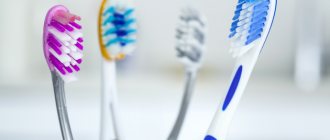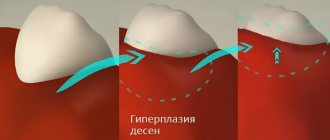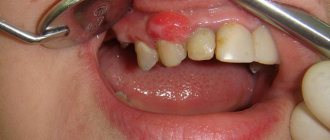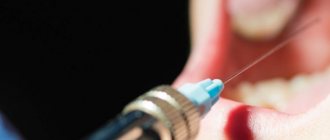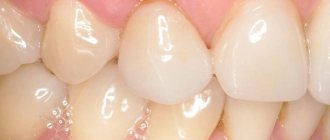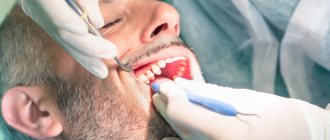Author of the article:
Soldatova Lyudmila Nikolaevna
Candidate of Medical Sciences, Professor of the Department of Clinical Dentistry of the St. Petersburg Medical and Social Institute, Chief Physician of the Alfa-Dent Dental Clinic, St. Petersburg
Dentists are often approached with such a problem as pain in the front teeth. There is nothing surprising. After all, although all our teeth have more or less the same internal structure, it is the incisors, due to their location, that are often subject to mechanical injuries.
In addition, our front teeth are distinguished by a thin layer of dentin (the bone tissue that makes up the bulk of the tooth). Because of this, caries on the incisors develops much faster than on other teeth.
Why do my front teeth hurt?
Front teeth can hurt for many reasons. Among them:
- Dental diseases, such as caries.
- Injuries to teeth and gums.
- Increased sensitivity of teeth.
- Incorrect treatment.
- Enamel wear.
- Inflammation of the facial nerve, which quite often occurs under stress.
- Inflammation of the gums, such as periodontitis.
In any case, only a qualified dentist can determine the cause of gum pain, so it is very important to see a doctor if you experience the slightest pain.
And in this article we will look in detail at the causes of pain.
Caries on front teeth
Carious formations do not appear overnight; it is always a gradual process due to the fact that pathogenic bacteria multiply in dental plaque and weaken the enamel. The destruction of the enamel gives microbes a “pass” into the tooth, where the pathological process grows, affecting healthy tissue.
Pain in the front teeth occurs at a late stage of caries, when the pulp is affected, including the nerve process that is part of it. That is, this symptom is no longer a reason to go to the dentist, but a persistent warning - it will only get worse.
It should be noted that carious formations are largely associated with insufficient oral hygiene. Other, less important factors include:
- lack of minerals in the diet;
- lack of solid food;
- heredity;
- systemic diseases that disrupt metabolism;
- dental injuries and others.
It is very important to brush your teeth correctly using suitable products. ASEPTA offers the best toothpastes for the whole family. They gently cleanse, saturating the enamel with minerals. A series of products for adults is designed specifically taking into account the needs of people. Thus, “ASEPTA PLUS” COFFEE AND TOBACCO eliminates the consequences of drinking strongly colored drinks and smoking cigarettes, and also whitens the enamel.
Trauma to a tooth or gum
If the enamel of a front tooth or gum is injured, pain may be felt. Upon examination, you may see cracks in the enamel, darkening or redness, and slight swelling of the soft tissue.
Tooth injuries are dangerous due to the development of caries, since cracks allow pathogenic bacteria to enter. You should definitely contact your dentist if you feel pain in your front teeth.
Increased tooth sensitivity
An intense tooth reaction to cold/hot or sweet foods is a sign of thinning enamel. The reasons for this can be different - from a lack of minerals in the body to metabolic diseases.
Increased sensitivity of enamel is a reason to schedule a visit to the doctor. He will determine the cause of this symptom and prescribe adequate treatment.
To reduce painful manifestations, use ASEPTA SENSITIVE paste, which will saturate the enamel with the missing mineral components.
Consequences of dental treatment
If you have recently had dental treatment and your tooth still hurts, you should think about the possible causes. So, on the first day after the intervention, pain in the front teeth is normal. It can be felt as an unpleasant weak sensation (you “feel the tooth”) or as a low-intensity aching pain. However, if it is excessive and difficult to bear, consult your doctor.
If painful symptoms continue for 3-4 days and the pain does not subside, this is a reason to visit the dentist again. Perhaps the treatment was carried out incorrectly or complications occurred.
Enamel wear
This phenomenon is uncommon, usually accompanies systematic violations of hygiene rules, some chronic diseases, or is associated with heredity. If you feel that your front teeth - lower or upper - are hurting, but you don’t notice any defects on them, this is also a reason to consult a dentist. If the discomfort is associated with abrasion of the enamel, the doctor will prescribe remineralizing procedures and also help adjust the diet. Thus, if there is a lack of minerals, it is recommended to use special vitamin and mineral complexes, for example, ASEPTA.
Inflammation of the facial nerve
Hypothermia, stress, decreased immunity due to illness - all this can lead to an inflammatory process in the facial nerve, which can be felt as pain in the front teeth and jaw. The feeling is very unpleasant. The pain is quite strong, acute, dulled only by a strong analgesic.
Be sure to consult a therapist with this problem. Try not to get too cold, drink more fluids, as it helps remove waste products.
Gum diseases
Problems with the gums can manifest themselves as pain in the front teeth; treatment in this case is aimed specifically at solving problems with soft tissues. The reasons for them are varied - from injury to non-compliance with hygiene standards. Only a doctor will determine what factors provoked the disease.
A visual examination of the gums may show tenderness, redness, and swelling. This is a reason to visit a doctor in the next 1-2 days.
Characteristic features of unilateral dentalgia
A sharp toothache, for example, on the left side can act as a symptom of a heart attack. If it is aching in nature, there is a high probability of trigeminal neuralgia. In these situations, self-medication is strictly prohibited due to the risk of complications. Therefore, at the first symptoms of dentalgia, you should consult a doctor.
Unilateral toothache usually occurs suddenly. It has a widespread course, when all dental units of both jaws are affected. It is also highly intense.
The pathological process can be provoked by inflammatory tissue pathologies, diseases of the vascular, nervous or cardiac systems. In most cases, patients note the appearance of acute, sometimes throbbing pain. Much less often they go to the doctor with dull pain.
Almost always, discomfort negatively affects people’s quality of life and their psycho-emotional state. They cannot eat or sleep normally, which leads to problems with the digestive tract and central nervous system.
A sleep disorder is diagnosed in almost 90% of patients with widespread dentalgia, since the pain syndrome intensifies at night. During rest, the functional activity of the adrenal cortex decreases. In addition, the natural synthesis of so-called steroid hormones, which have analgesic properties, is reduced.
If the cause of dentalgia is dental disorders, the discomfort intensifies after direct contact with cold or eating excessively spicy or hot foods. It is enough just to open your mouth in frosty or windy weather for the pain syndrome to sharply intensify.
Psychosomatic dentalgia is often a consequence of stressful situations and strong psycho-emotional experiences. To eliminate discomfort, it is often enough to eliminate the provoking factor. Some patients benefit from sessions with a psychotherapist or taking mild sedatives.
What can cause pain on the front teeth?
First of all, the fact that the front lower or upper teeth hurt, of course, is due to incorrect or insufficient oral hygiene. You can also identify such provoking factors as:
- constant mechanical impact, for example, due to a love of nuts or seeds;
- non-compliance with the dentist’s recommendations after treatment;
- bruxism (grinding teeth in sleep);
- untreated teeth in the mouth;
- hereditary predisposition;
- poor nutrition;
- occupational hazards (boxers, trumpet players, etc.);
- using forks, toothpicks, needles to clean interdental spaces;
- malocclusion.
It is important not to forget that the gap between the front teeth is often so narrow that it is impossible to get any leftover food out of it. This is why flossing your front teeth is important. It is also very important to visit the dentist on time, since carious stains are often located on the inner surface of the tooth, and only a doctor can see them.
If your front teeth hurt, most likely this means that pulpitis has begun to develop due to advanced caries.
First, the tooth begins to respond acutely to temperature fluctuations (hot drinks, cold weather, etc.), then it begins to bother you when biting food. At a later stage, sharp pain in the front teeth can occur at any time, even during sleep.
In this case, you need to contact your dentist, and the sooner the better. Only he can cure this disease and restore health and beauty to your smile.
Pathologies of ENT organs
Unilateral dentalgia may be a consequence of diseases of the ENT organs, which is due to the structural features of the oropharynx, nasopharynx, and ears. We are talking, first of all, about adenoiditis, otitis media and sinusitis. The help of an otolaryngologist to exclude and differentially diagnose ENT diseases will be required in cases where unilateral dentalgia is combined:
- nasal congestion, when the patient loses the ability to breathe fully;
- headaches;
- the occurrence of discharge from the ears (a clear symptom of purulent otitis media);
- high temperature;
- pain in the ears;
- sore throat;
- copious purulent discharge from the nose.
When the inflammatory process in the paranasal sinuses or middle ear acts as a provoking factor for unilateral dentalgia, the pain goes away on its own after it stops. Broad-spectrum antibiotics (macrolides, cephalosporins, penicillin medications) are used for treatment. Additionally, anti-inflammatory and antibronchoconstrictor drugs (Fenspiride), as well as drugs to stimulate the motor function of the respiratory tract (Sinupret) are prescribed.
Treatment of anterior teeth
Many people are interested in whether the front teeth are treated. Of course they do. True, the accuracy, precision, experience and qualifications of the doctor are important in this case, because the front teeth are very thin and can be easily damaged.
An experienced doctor will do everything possible to keep the tooth intact and at the same time remove carious lesions. Quite often, the front teeth suffer from pulpitis.
How are anterior teeth with pulpitis treated? To do this, the doctor uses local anesthesia, and after the medicine takes effect, the dentist removes the affected nerve, then carefully cleans the canals and seals them. And only after that he directly begins to restore the tooth.
And to make sure that the treatment was carried out correctly, the doctor may additionally order an image to be taken after the filling.
If you feel that your front tooth hurts after treatment, immediately visit the dentist and tell us about this problem.
For your part, try to prevent the occurrence of caries and pulpitis. Maintain diligent oral hygiene, in addition to regularly brushing your teeth morning and evening, using dental floss and disinfectant rinses. We recommend using products from the ASEPTA line, which are developed and produced by the pharmaceutical industry.
It is also necessary to monitor your diet, eating fresh fruits and vegetables, fish, dairy products and limiting sweets and starchy foods.
Toothache as a sign of a heart attack
A heart attack is a cardiovascular pathology. It is also one of the clinical forms of ischemic disease. The mortality rate for heart attack is more than 60%.
Intact toothache on the left side of the jaw is considered one of the precursors of vascular pathology. It occurs 12-24 hours before an attack. Along with dentalgia, patients complain of headache, shortness of breath, nonproductive cough and changes in the normal heart rhythm.
The main symptom of a heart attack is considered to be angular pain. It appears 10-20 hours after the first manifestations. The duration of the attack itself varies from several minutes to an hour. To stop it, you need to take a Nitroglycerin tablet.
Clinical researches
During clinical trials using a series of Asepta products, conducted in the department of periodontology of the Central Research Institute of Dentistry and Maxillofacial Surgery of Rosmedtekhnologii, Moscow, the high effectiveness of Asepta products for moderate periodontitis was proven. The use of Asepta mouth rinse turned out to be quite effective. In addition, no phenomena of mucosal irritation or brown staining of fillings were recorded. This indicates that the use of this rinse for a two-week period provides an obvious clinical effect in the absence of negative side effects.
Sources:
- Report on determining/confirming the preventive properties of commercially produced personal oral hygiene products: Asepta toothpaste used in combination with Asepta mouthwash and Asepta gum balm Head. Department of PFS Doctor of Medical Sciences Professor S.B. Ulitovsky St. Petersburg State Medical University named after Academician I.P. Pavlova. Faculty of Dentistry. Department of Preventive Dentistry.
- Clinical experience in using the Asepta series of products Fuchs Elena Ivanovna Assistant of the Department of Therapeutic and Pediatric Dentistry State Budgetary Educational Institution of Higher Professional Education Ryazan State Medical University named after Academician I.P. Pavlova of the Ministry of Health and Social Development of the Russian Federation (GBOU VPO RyazSMU Ministry of Health and Social Development of Russia)
- Clinical and laboratory assessment of the influence of domestic therapeutic and prophylactic toothpaste based on plant extracts on the condition of the oral cavity in patients with simple marginal gingivitis. Doctor of Medical Sciences, Professor Elovikova T.M.1, Candidate of Chemical Sciences, Associate Professor Ermishina E.Yu. 2, Doctor of Technical Sciences Associate Professor Belokonova N.A. 2 Department of Therapeutic Dentistry USMU1, Department of General Chemistry USMU2
Health care
The occurrence of dentalgia is a signal to seek medical help. If toothache appears above and below, you should not self-medicate. You need to make an appointment with the dentist. If the pain syndrome does not allow you to sleep and do your usual activities, it is better to contact the emergency clinic.
At home and only as an emergency measure, non-narcotic analgesics and non-steroidal anti-inflammatory drugs are allowed. The most popular drugs from these groups, their approximate dosage are presented in the table below.
| Drug name | Single dosage | Maximum daily dosage |
| Analgin | 500 mg | 3000 mg of active substance |
| Citramon | 1 tablet | 3 tablets |
| Ketorol | 10 mg of active ingredient | 40 mg of active ingredient |
| Paracetamol | 500 mg | 4000 mg of active ingredient |
| Mefenamic acid | 500 mg of active substance | no more than 2000 mg of active substance |
| Diclofenac | 25 mg of active substance | no more than 150 mg of active substance |
| Ibuprofen | up to 800 mg | 2400 mg of active substance |
The dosages presented in the table are advisory in nature and selected for adult patients. For children, these indicators are calculated individually and only according to the instructions included with the drug.
Diagnosis and treatment
If a tooth aches without signs of caries, contact a dental clinic. Only a specialist can exclude the possibility of carious lesions and make an accurate diagnosis. Typically, diagnosis includes examination and x-rays.
The treatment regimen is drawn up taking into account the clinical picture. Treatment may be directed:
- for remineralization of enamel,
- elimination of factors that provoke pain,
- restoration of the integrity of the dental unit,
- decreased tooth sensitivity,
- strengthening gums and eliminating inflammation.
The doctor will provide more detailed information about treatment during the consultation.
Causes
Accurate diagnosis is important for a positive treatment outcome. It is this that allows you to determine why the tooth is inflamed. There are 3 diseases hidden under the general term.
Pulpitis
Microbes penetrate through the dentin layer to the neurovascular bundle - the pulp. People call it a nerve. Usually, this happens with deep caries. The pulp is penetrated by nerve endings. The pain is often acute and difficult to endure. But sometimes it is not strong, periodic. We ignore it and the inflammation becomes chronic, destroying the pulp. A small bun makes a huge difference:
- produces secondary dentin, therefore, although the height of the teeth changes throughout life, they do not disappear completely;
- participates in tissue metabolic processes;
- conducts nerve impulses.
When the pulp dies, the tooth is said to become “dead.” Such teeth are quickly destroyed.
To treat pulpitis in dentistry, therapeutic and surgical methods are used. In the first case, medications are placed into the tooth cavity and closed with a temporary filling. After some time, the tampon with the medicine is removed and the tooth is filled. This method does not always help relieve inflammation inside the tooth.
If the process has gone far, the pulp or part of it is removed and then a permanent filling is placed.
Periodontitis
Under the crown of the tooth there is connective tissue - periodontium. As a result of injury or poor treatment, microbes penetrate there, causing inflammation of the tooth root - periodontitis.
.
There is an apical form, when only the apex is affected, and a marginal form, when all the tissue around the root is infected.
Symptoms of periodontitis:
- pain while eating or when jaws touch;
- feeling that the tooth stands out from the row (has become taller);
- temperature increase;
- tissue redness;
- tooth mobility;
- discharge of pus.
Periodontitis is an insidious enemy. Often the disease occurs without symptoms. It can only be suspected when the signs of the disease become pronounced: roots are exposed, gums bleed, pus is released, bone tissue decreases.
Treatment depends on the type of periodontitis and severity:
- Therapeutic method
The doctor opens access to the root canals, removes part or all of the pulp, and installs drainage to drain the pus. After a few days, the drainage is removed, the canals and tooth are processed and filled. It is recommended to place a crown on such a tooth.
- Surgical method
They resort to it if fibrosis has developed or there are granulomas.
Dentist:
- Cuts off the root tip
- Removes 1 root in multi-rooted teeth
- Amputates the root but leaves the crown intact
- Removes a tooth
- Performs separation (cuts the tooth in half, cleans it and puts it back together)
A course of antimicrobial tablets helps relieve inflammation inside the tooth.
Periodontitis
Periodontium is the fibers that hold the tooth in its socket. Plaque allows bacteria from it to penetrate into the periodontium and begin to rapidly multiply, forming a periodontal pocket. From the pocket, it is easy for them to get under the crown of the tooth and cause an inflammatory process there.
Before treating tooth inflammation under the crown, periodontal pockets are curetted, freeing the surface from tartar and plaque. Then they begin other manipulations: getting rid of caries, splinting teeth. Often, for periodontitis, a course of antibiotics is prescribed. The inflammation must be stopped so that the tooth does not have to be removed.

